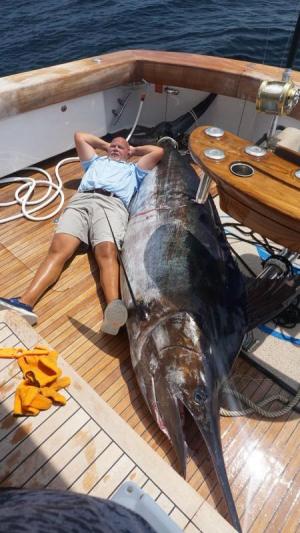Back in 1974, a man named Jim Motsko had an idea. He wanted to have a white marlin tournament in Ocean City, Md., to prove it was the white marlin capital of the world. I was fortunate to be asked to go out with Jim in that first tournament, and while we didn’t catch the winning fish, the White Marlin Open was a success and has grown just a bit during the last 45 years.
Fewer than 100 boats fished the first White Marlin Open. By the early 2000s, there were more than 400. Prize money has grown from a few thousand dollars to $5 million this year.
I have covered more than half of these tournaments, and this year, thanks to Jim Motsko, I was invited to go on the Toast, out of Florida. Owner Ron Martin and Capt. Brian Ciscoski have put together a great team of anglers and mates, including Katrina Hughes, who between preparing gourmet meals also works the cockpit getting baits ready and cleaning up after the trip.
On Monday, I arrived at Harbour Island Marina around 3:45 a.m. to find the crew getting ready for the day. Once all hands were onboard, we headed out of Ocean City Inlet while an unbelievable number of folks watched us depart from the north jetty. When people first lined up to see the fleet set out in the dark, we figured these were people who had not gotten home from their Sunday night adventures. But now we can watch them drive in and park before lining the jetty. What inspires people to get up this early to watch these boats run out is beyond me.
We arrived at the Washington Canyon around 8 a.m., 30 minutes before lines in, giving the captain time to look around for good concentrations of bait and any temperature changes. Once the lines, teasers and dredges were deployed, all there was to do was work hard to interest a white marlin in our offerings. And work hard this crew did.
The three anglers held the four lines attached to the TLD 30-pound reels so they would feel even the lightest pickups. Unfortunately, Day 1 only provided hits from three dolphin, none of which were large enough to meet the 20-pound minimum weight.
Day 2 was a repeat of Day 1, and once again we cleared the inlet around 4:30. We ran back to the Washington, but the captain moved about seven miles from our Day 1 position. It proved to be a wise decision.
The baits had been in the water only eight minutes when we hooked up the first white of the day. The angler brought it in with the captain maneuvering the boat to put us in position to land the fish. As soon as it hit the dock it was measured, found to be just a bit short, and released.
The rest of the day proved to be good, as we caught and released three more white marlin.
On Day 1 of the tournament, the Auspicious, out of Florida, landed an 881-pound blue marlin to take the lead in that category. It was Day 2 before the Lights Out brought in a 75-pound white marlin, and, as of Wednesday, it was the only qualifying white for the tournament. The tuna category is led by the Brass Monkey with a 71-pounder. I think the blue marlin has a good chance of holding up, but the white marlin and the tuna can be beaten. We will know all by Friday night.
Fishing report
If you are in the right place at the right time, you can catch flounder. I went out with Jeff Waxman on his boat for a few hours of flounder fishing Sunday. We left the dock at 10 a.m., ran to A Buoy and were back by 2 p.m., with three keepers in the box. All were caught on Gulp! twister tails in nuclear chicken. Flounder continue to come from the Lewes-Rehoboth Canal, the fishing pier at Cape Henlopen State Park and Indian River Inlet.
Tuna chunking has been good at Massey’s Canyon. There are a lot of boats out there during the weekends, but if you can find a spot with good bottom structure away from the fleet, your chances of connecting with a bluefin or yellowfin are pretty good.
Trolling with small spoons over the wrecks at Fenwick Shoal produces bluefish, and Spanish and king mackerel. Bottom fishing the same wrecks can put triggerfish in the cooler.
Delaware Bay reef sites hold kings, blues, croaker and blowfish. Small bits of bloodworms or clams on small hooks will bring in these fish. Live minnows fished on a Carolina rig will work for the flounder.


























































